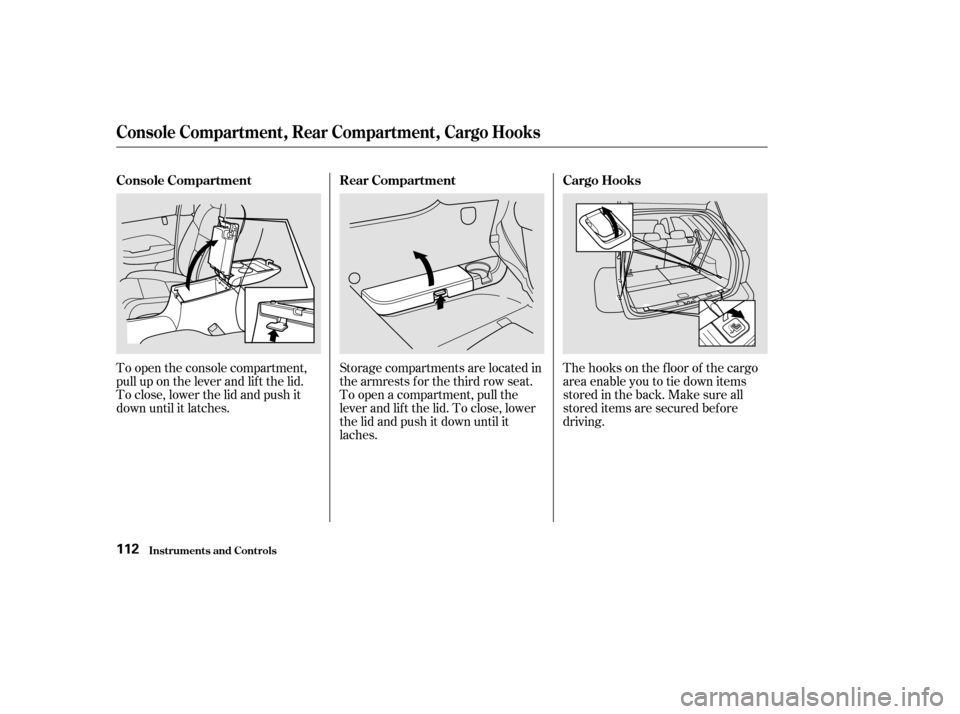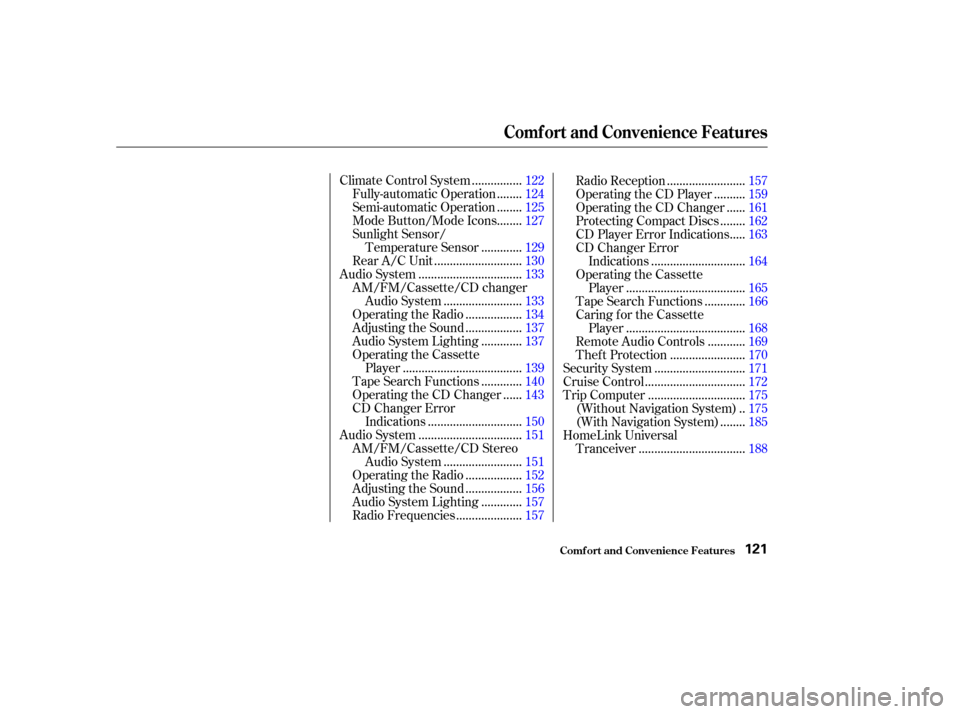ECU Acura MDX 2002 Owner's Guide
[x] Cancel search | Manufacturer: ACURA, Model Year: 2002, Model line: MDX, Model: Acura MDX 2002Pages: 372, PDF Size: 5.48 MB
Page 116 of 372

The hooks on the f loor of the cargo
area enable you to tie down items
stored in the back. Make sure all
stored items are secured bef ore
driving.
To open the console compartment,
pull up on the lever and lif t the lid.
To close, lower the lid and push it
down until it latches.
Storage compartments are located in
the armrests f or the third row seat.
To open a compartment, pull the
lever and lif t the lid. To close, lower
the lid and push it down until it
laches.
Inst rument s and Cont rols
Console Compart ment , Rear Compart ment , Cargo Hooks
Console Compartment
Rear Compartment Cargo Hooks
112
01/09/07 12:13:30 31S3V610_117
Page 125 of 372

...............
Climate Control System .122
.......
Fully-automatic Operation .124
.......
Semi-automatic Operation .125
.......
Mode Button/Mode Icons .127
Sunlight Sensor/
............
Temperature Sensor .129
...........................
Rear A/C Unit .130
................................
Audio System .133
AM/FM/Cassette/CD changer ........................
Audio System .133
.................
Operating the Radio .134
.................
Adjusting the Sound .137
............
Audio System Lighting .137
Operating the Cassette
.....................................
Player .139
............
Tape Search Functions .140
.....
Operating the CD Changer .143
CD Changer Error
.............................
Indications .150
................................
Audio System .151
AM/FM/Cassette/CD Stereo ........................
Audio System .151
.................
Operating the Radio .152
.................
Adjusting the Sound .156
............
Audio System Lighting .157
....................
Radio Frequencies .157 ........................
Radio Reception .157
.........
Operating the CD Player .159
.....
Operating the CD Changer .161
.......
Protecting Compact Discs .162
....
CD Player Error Indications .163
CD Changer Error
.............................
Indications .164
Operating the Cassette .....................................
Player .165
............
Tape Search Functions .166
Caring f or the Cassette
.....................................
Player .168
...........
Remote Audio Controls .169
.......................
Thef t Protection .170
............................
Security System .171
...............................
Cruise Control .172
..............................
Trip Computer .175
.
(Without Navigation System) .175
.......
(With Navigation System) .185
HomeLink Universal .................................
Tranceiver .188
Comf ort and Convenience Features
Comf ort and Convenience Feat ures121
01/09/07 12:14:47 31S3V610_126
Page 175 of 372

Once the security system is set,
opening any door (without using the
key or the remote transmitter), or
the hood, will cause it to alarm. It
also alarms if the radio is removed
f rom the dashboard or the wiring is
cut.
The security system sets auto-
matically fifteen seconds after you
lock the doors, hood, and trunk. For
the system to activate, you must lock
the doors f rom the outside with the
key, lock tab, door lock switch, or
remote transmitter. The security
system light next to the driver’s door
lock starts blinking immediately to
show you the system is setting itself . The security system helps to protect
your vehicle and valuables f rom thef t.
The horn sounds and a combination
of headlights, parking lights, side
marker lights and taillights f lashes if
someone attempts to break into your
vehicleorremovetheradio.This
alarm continues f or two minutes,
then the system resets. To reset an
alarming system before the two
minutes have elapsed, unlock the
driver’s f ront door with the key or
the remote transmitter.
Do not attempt to alter this system
or add other devices to it. The security system will not set if
the hood, tailgate, or any door is not
f ully closed. If the system will not set,
check the Door and Tailgate Open
Monitor on the instrument panel
(see page ), to see if the doors
and tailgate are f ully closed. Since it
isnotpartofthemonitordisplay,
manually check the hood.64
Security System
Comf ort and Convenience Feat ures171
S SE
EC
CU UR RIITT Y
Y S
SYYSSTTE
EM
M L
LIIGGH HT
T
01/09/07 12:22:17 31S3V610_176
Page 192 of 372

Always ref er to the operating
instructions and saf ety inf ormation
that came with your garage door
opener or other equipment you
intend to operate with the HomeLink
Universal Transceiver. If you do not
have this inf ormation, you should
contact the manuf acturer of the
equipment.
While training or using HomeLink,
make sure you have a clear view of
the garage door or gate, and that no
one will be injured by its movement.The HomeLink transceiver stores
the code in a permanent memory.
There should be no need to retrain
HomeLink if your car’s battery goes
dead or is disconnected.
If your garage door opener was
manuf actured bef ore April 1982, you
may not be able to program
HomeLink to operate it. Garage door
openers manuf actured bef ore that
date do not have a safety feature that
causes them to stop and reverse if an
obstacle is detected during closing,
increasing the risk of injury. If you
have questions, call (800) 355-3515.
If you are training HomeLink to
operate a garage door or gate, it is
recommended that you unplug the
motor f or that device during training.
Repeatedly pressing the remote
control button could burn out the
motor.
If you have problems with training
the HomeLink Universal Transceiver,
or would like inf ormation on home
products that can be operated by the
transmitter, call (800) 355-3515. On
the Internet, go to www.homelink.
com. The HomeLink Universal
Transceiver built into your vehicle
canbeprogrammedtooperate
remotely-controlled devices around
your home, such as garage doors,
lighting, or home security systems. It
can replace up to three remote
transmitters.
Important Saf ety Precautions
General Inf ormation
Customer Assistance
HomeL ink Universal T ransceiver
Comf ort and Convenience Feat ures188
01/09/07 12:24:58 31S3V610_193
Page 194 of 372

Canadian Owners:
The remote control you are training
from may stop transmitting after two
seconds. This is not long enough f or
HomeLink to learn the code. Release
and press the button on the remote
control every two seconds until
HomeLink has learned the code.For security purposes, newer garage
door opening systems use a ‘‘rolling’’
or variable code. Inf ormation f rom
the remote control and the garage
door opener are needed bef ore
HomeLink can operate the garage
door opener.
The ‘‘Training HomeLink’’
procedure trains HomeLink to the
proper garage door opener code.
The f ollowing procedure
synchronizes HomeLink to the
garage door opener so they send and
receive the correct codes.
The red light in HomeLink should
begin f lashing. It will f lash slowly
at first, then rapidly.
When the red light f lashes rapidly,
release both buttons. HomeLink
should have learned the code from
the remote control.
Plug in the garage door opener
motor, then test the HomeLink
transceiver button by pushing it. It
should operate the garage door.
If the button does not work, repeat
this procedure to train it again. If it
still does not work, you may have a variable or rolling code garage
door opener. Test this by pressing
and holding the HomeLink
transceiver button you just trained.
If the red light blinks f or two
seconds,thenstayson,youhavea
rolling code garage door opener.
You may be able to verify this with
the manufacturer’s documentation.
Go to ‘‘Training With a Rolling
Code System.’’
Repeat these steps to train the
other two HomeLink buttons to
operate any other remotely-
controlled devices around your
home (lighting, automatic gate,
security system, etc.).
5.
6.
8.
7. T raining With a Rolling Code
System
HomeL ink Universal T ransceiver
Comf ort and Convenience Feat ures190
01/09/07 12:25:20 31S3V610_195
Page 201 of 372

CONT INUED
If you can open the hood without
lifting the hood latch handle, or the
hood latch handle moves stif f ly or
does not spring back as bef ore, the
mechanism should be cleaned and
lubricated (see page ).Lif t the hood up most of the way.
The hydraulic supports will lif t it
uptherestof thewayandholdit
up.
To close the hood, lower it to about a
f oot (30 cm) above the f ender, then
press down f irmly with your hands.
After closing the hood, make sure it
is securely latched.
Standing in f ront of the vehicle,
put your f ingers under the f ront
edge of the hood to the left of
center. Slide your hand to the lef t
until you f eel the hood latch
handle. Push this handle up until it
releases the hood. Lif t the hood. 3.
2. 277
Service Station Procedures
Bef ore Driving197
L LA
A T
TC
CH H
01/09/07 12:26:25 31S3V610_202
Page 208 of 372

Store or secure all items that could
be thrown around and hurt
someone during a crash.
Be sure items placed on the f loor
behind the f ront seats cannot roll
under the seats and interf ere with
the driver’s ability to operate the
pedals, or with the proper
operation of the seats.
Keep the glove box closed while
driving. If the lid is open, a
passenger could injure their knees
during a crash or sudden stop.
This f igure includes the total weight
of all occupants, cargo, accessories,
and the tongue weight if you are
towing a trailer.
The f inal number is the total weight
of cargo you can carry.
If you are towing a trailer, add the
tongue weight to the number
above. Add up the weight of all occupants.
To f igure out how much cargo you
can carry: When you load luggage, the total
weight of the vehicle, all passengers,
cargo, and trailer tongue load must
not exceed the Gross Vehicle
Weight Rating (GVWR). The load
for the front and rear axles also must
not exceed the Gross Axle Weight
Rating (GAWR). The GVWR and
GAWRareprintedonthetire
information label attached to the
driver’s doorjamb (see page ).
Subtract the total f rom 1,158 lbs
(525 kg).
The maximum load f or your vehicle
is 1,158 lbs (525 kg).
342Carrying Items in the Passenger
Compartment
Load Limit
Carrying Cargo
Bef ore Driving204
Overloading or improper
loading can affect handling and
stability and cause a crash in
which you can be hurt or killed.
Follow all load limits and other
loading guidelines in this
manual.
01/09/07 12:27:41 31S3V610_209
Page 209 of 372

Distribute cargo evenly on the
f loor of the cargo area, placing the
heaviest items on the bottom and
as far forward as possible. Tie
down items that could be thrown
about the vehicle during a crash or
sudden stop.If you use an accessory roof rack,
the roof rack weight limit may be
lower. Ref er to the inf ormation that
came with your roof rack.If you can carry any items on a
roof rack,besurethetotalweight
of the rack and the items on it
does not exceed 165 lb (75 kg).
Theseparationnetcanbeusedto
hold back sof t, lightweight items
stored in the cargo area. Heavy
items should be properly secured on
the f loor of the cargo area. The net
may not prevent heavy items f rom
being thrown f orward in a crash or a
sudden stop.
The cargo cover can be used to
cover the cargo area behind the third
row seats. When the third row seats
are folded down, the cargo cover can
be installed in a f orward position and
extended over the larger cargo area.
Do not install the cargo cover in the
f orward position if the third row
seats are not f olded down.
If you carry large items that
prevent you f rom closing the
tailgate, exhaust gas can enter the
passenger area. To avoid the
possibility of carbon monoxide
poisoning, f ollow the instructions
on page .
56
Carrying Cargo in the Cargo A rea
or on a Roof Rack
Optional Separation Net
Optional Cargo Cover
Carrying Cargo
Bef ore Driving205
01/09/07 12:27:52 31S3V610_210
Page 213 of 372

Youshoulddothefollowingchecks
and adjustments every day bef ore
you drive your vehicle.Make sure all windows, mirrors,
and outside lights are clean and
unobstructed. Remove f rost, snow,
or ice. Check the adjustment of the seat
(see page ).
Check the adjustment of the
inside and outside mirrors (see
page ).
Check the adjustment of the
steering wheel (see page ).
Fasten your seat belt. Check that
your passengers have f astened
their seat belts (see page ).Turn the ignition switch ON (II).
Check the indicator lights in the
instrument panel.
Start the engine (see page ).
Check the gauges and indicator
lights in the instrument panel (see
page ).
Check that any items you may be
carrying with you inside are stored
properly or f astened down
securely. Visually check the tires. If a tire
looks low, use a gauge to check its
pressure. Check that the hood and tailgate
arefullyclosed. Makesurethedoorsandtailgate are securely closed and locked.
3. 2.
1.
4. 5.
6.
7.
8.
9. 11.
12. 10.
15
92
104 78 61 210
Preparing to Drive
Driving209
01/09/07 12:28:24 31S3V610_214
Page 236 of 372

Discuss any additional needs with
your trailer sales or rental agency,
and make sure all equipment is
properly installed and maintained.
Since local requirements may vary,
check with appropriate state
authorities to be sure that your
equipment will meet all regulations
in the areas where you plan to tow. Towing generally requires a variety
of supplemental equipment. To
ensure the best quality, we
recommend that you purchase Acura
equipment whenever possible. Your
dealer offers a trailer package that
includes a hitch, a ball mount, a
wiring harness, a transmission f luid
cooler and a heavy-duty power
steering f luid cooler.We strongly recommend that you
have your Acura dealer install a
genuine Acura hitch and the
required f luid coolers. Using non-
Acura equipment may result in
serious damage to your vehicle.
A weight distributing hitch is not
recommended f or use with your
MDX as an improperly adjusted
weight distributing hitch may reduce
handling stability and braking
perf ormance.
Always use saf ety chains when you
tow a trailer. Make sure the chains
are secured to the trailer and hitch,
and that they cross under the tongue
so they can catch the trailer if it
becomes unhitched. Leave enough
slack to allow the trailer to turn
corners easily, but to do not let the
chains drag on the ground.This device is recommended if your
trailer tends to sway. Your trailer
maker can tell you what kind of sway
control you need and how to install it.
To help prevent overheating, a
heavy-duty transmission f luid cooler
and a heavy-duty power steering
f luid cooler are required f or trailer
towing. These coolers are available
only f rom your Acura dealer.
Towing a Trailer
Driving
T owing Equipment and
A ccessoriesHitch
Weight Distributing HitchSaf et y Chains Sway Cont rol
T ransmission Fluid Cooler andPower St eering Fluid Cooler
232
01/09/07 12:32:08 31S3V610_237